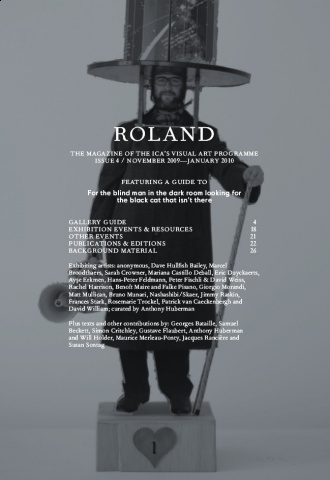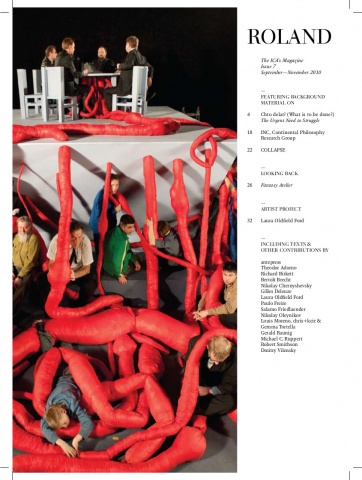Andrei Smirnov, Liubov Pchelkina: Generation Z: Russian Pioneers of Sound Art and Musical Technology in 1910-1930 (2011) [English/Hungarian]
Filed under booklet | Tags: · 1910s, 1920s, art, art history, avant-garde, music, music history, russia, sound, sound art, technology, utopia

Variophone, theremin terpsitone, rhythmicon, emiriton, ekvodin, graphical sound – just to mention a few of the amazing innovations of the beginning of the 20th century in Soviet Russia, a country and time turbulent with revolutions, wars and totalitarian dictatorship.
While the history of Russian post-revolutionary avant-garde art and music is fairly well documented, the inventions and discoveries, names and fates of researchers of sound, creators of musical machines and noise orchestras, founders of new musical technologies have been largely forgotten except, perhaps, Leon Theremin, inventor of the first electronic musical instrument, the theremin.
This community of creators, however, was inherently incompatible with the totalitarian state. By the late 1930s it became effectively written out of histories, wiped out from text books.
Many of their ideas and inventions, considered as utopian at that time, were decades later rein¬vented abroad. We still use them today not knowing their origin.
This booklet was produced for the Budapest edition of a traveling exhibition curated by Andrei Smirnov of the Theremin Center and Liubov Pchelkina of the State Tretyakov Gallery.
Publisher OSA Archivum, Budapest, 2011
ISBN 9789638853820
20 pages
exhibition (from the curators)
exhibition (gallery website)
Roland, The ICA’s Magazine, 1-9 (2009-2011)
Filed under magazine | Tags: · art, art criticism, contemporary art, london, music


Roland Issue 1: Talk Show (May 2009)
A guide to Talk Show exhibition, with texts and contributions by Malcolm Goldstein, Ernest Robson, Will Holder, Robert Ashley, Alvin Lucier, Ricardo Basbaum, Anne Karpf, Susan Blackmore, Konstantin Raudive,Will Bradley, Gertrude Stein, Joan La Barbara, Marc Hatzfeld, Marshall Mcluhan, Mikhail Yampolsky, Chris Mann, Hélène Cixous, BS Johnson, Ja Chung and Q Takedi Maeda, Paul Virno and Shigeru Matsui.
Roland Issue 2: Poor. Old. Tired. Horse. (June-August 2009)
A guide to the Poor. Old. Tired. Horse. exhibition with texts and contributions by Charlotte Bonham-Carter, Augusto de Campos, Lewis Carroll, Michelle Cotton, Douglas Coupland, Eugen Gomringer, George Herbert, Joseph Kosuth, Liz Kotz, Giles Round, Stephen Scobie, Tris Vonna-Michell and William Carlos Williams.
Roland Issue 3: Rosalind Nashashibi (September-October 2009)
A guide to Rosalind Nashsahibi with texts and contributions by Claire Denis, Anselm Franke, Martin Herbert, Mark Leckey, G. Ch. Lichtenberg, Thomas Mann, Jonas Mekas, Pier Paolo Pasolini and Marcel Proust.
Roland Issue 4: For the blind man… (December 2009)
A guide to the exhibition For the blind man in the dark room looking for the black cat that isn’t there with contributions by Georges Bataille, Samuel Beckett, Simon Critchley, Gustave Flaubert, Anthony Huberman and Will Holder, Maurice Merleau-Ponty, Jacques Rancière and Susan Sontag.
Roland Issue 5: Billy Childish (February-April 2010)
A guide to Billy Childish: Unknowable but Certain with texts and contributions by Max Beckmann, Richard Birkett, Neal Brown, Charles Bukowski, Martin Clark, Louis-Ferdinand, Céline, Bo Diddley, Knut Hamsun, Matthew Higgs, Jutta Koether and Robert Walser
Roland Issue 6: Oscar Tuazon (June-August 2010)
The sixth issue of ROLAND features highlights from across the institute’s programme including the solo exhibition by Oscar Tuazon, the post-punk band Gang of Four, a symposium on the politics of community, the release of Harmony Korine’s Trash Humpers, and the London International Festival of Theatre.
Roland Issue 7: Chto delat? (What is to be done?) (September-November 2010)
This publication includes introductions to and background material on the Chto delat? exhibition The Urgent Need to Struggle, the release in our cinema of documentary film Collapse and a series of seminars and talks organised by InC, Continental Philosophy Research Group. We also take a look back at May’s architectural workshop Fantasy Atelier, and feature new work from Laura Oldfield Ford.
Roland Issue 8: Rhythm Section (November 2010 – February 2011)
This issue highlights the return of Bloomberg New Contemporaries to the ICA; Rhythm Section, a five-day event that explores the experimental potential of the percussive technique; an in-depth look at the work of artist-filmmaker Gustav Deutsch; a residency with London-based architects 6a, and a debate on the position of painting within contemporary art.
Roland Issue 9: Nathaniel Mellors (February-May 2011)
This issue of ROLAND includes introductions and information on Nathaniel Mellors, Birds Eye View Film Festival as well as the The Last of the Red Wine, Notation & Interpretation, and Shunt Live Weekends.
Publisher Institute of Contemporary Arts, London
Comments (3)Seth Kim-Cohen: In the Blink of an Ear: Toward a Non-Cochlear Sonic Art (2009)
Filed under book | Tags: · art, art history, music, music history, musique concrète, ontology, phenomenology, rock'n'roll, sculpture, sound, sound art

“An ear-opening reassessment of sonic art from World War II to the present.
Marcel Duchamp famously championed a “non-retinal” visual art, rejecting judgments of taste and beauty. In the Blink of an Ear is the first book to ask why the sonic arts did not experience a parallel turn toward a non-cochlear sonic art, imagined as both a response and a complement to Duchamp’s conceptualism. Rather than treat sound art as an artistic practice unto itself—or as the unwanted child of music—artist and theorist Seth Kim-Cohen relates the post-War sonic arts to contemporaneous movements in the gallery arts. Applying key ideas from poststructuralism, deconstruction, and art history, In the Blink of an Ear suggests that the sonic arts have been subject to the same cultural pressures that have shaped minimalism, conceptualism, appropriation, and relational aesthetics. Sonic practice and theory have downplayed – or, in many cases, completely rejected – the de-formalization of the artwork and its simultaneous animation in the conceptual realm.
Starting in 1948, the simultaneous examples of John Cage and Pierre Schaeffer initiated a sonic theory-in-practice, fusing clement Greenberg’s media-specificity with a phenomenological emphasis on perception. Subsequently, the “sound-in-itself” tendency has become the dominant paradigm for the production and reception of sound art. Engaged with critical texts by Jacques Derrida, Rosalind Krauss, Friedrich Kittler, Jean François Lyotard, and Jacques Attali, among others, Seth Kim-Cohen convincingly argues for a reassessment of the short history of sound art, rejecting sound-in-itself in favor of a reading of sound’s expanded situation and its uncontainable textuality. At the same time, this important book establishes the principles for a nascent non-cochlear sonic practice, embracing the inevitable interaction of sound with the social, the linguistic, the philosophical, the political, and the technological.
Artists discussed include: George Brecht, John Cage, Janet Cardiff, Marcel Duchamp, Bob Dylan, Valie Export, Luc Ferrari, Jarrod Fowler, Jacob Kirkegaard, Alvin Lucier, Robert Morris, Muddy Waters, John Oswald, Marina Rosenfeld, Pierre Schaeffer, Stephen Vitiello, La Monte Young.”
Publisher Continuum, New York/London, 2009
ISBN 082642970X, 9780826429704
296 pages
Reviews: Laura Paolini (MusicWorks, 2010), Will Scrimshaw (2010), Brian Kane (NonSite, 2013).
PDF (updated on 2020-7-13)
Comments (5)
